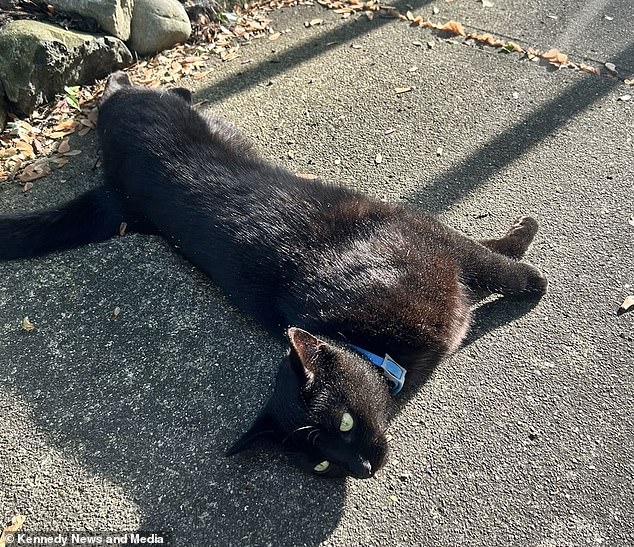Heroic Cat! Grumpy cat saves woman’s life after bite from angry pet leads doctors to discover her cancer
Black cats bring bad luck, but for this woman, a bite from an angry cat saved her life.
Animal lover Emily Falk, 25, from Port Huron, USA, had no qualms when she was bitten by her neighbor’s black cat Edgar in May while she was petting him.
But a week later, she discovered a lump the size of a golf ball under her armpit.
Initially, she dismissed this as a possible case of cat scratch disease, a bacterial infection that can be caused by a bite or scratch from a cat.
Only when a course of antibiotics failed to clear the suspected infection did Mrs Falk seek further medical advice.
Animal lover Emily Falk, 25, from Port Huron, USA, didn’t think twice when she was bitten by her neighbor’s black cat Edgar while she was petting him in May

But a week later, she discovered a “golf ball sized” lump under her armpit. She initially dismissed it as a possible case of cat scratch disease — a bacterial infection that can be caused by a cat bite or scratch. Pictured: Black cat Edgar

It was only after a course of antibiotics failed to clear up the suspected infection that Mrs Falk sought further medical advice. A subsequent ultrasound and biopsy revealed that the truth was far more serious. Pictured: Mrs Falk during her first course of chemotherapy
A subsequent ultrasound and biopsy revealed that the truth was much more serious.
Mrs. Falk had She was diagnosed with Hodgkin’s lymphoma, a rare form of cancer that originates in the white blood cells, and began chemotherapy.
Mrs Falk told of her ordeal: ‘I think the cat bite saved my life in a way.
“I don’t think I would have gone to the doctor so quickly, but it certainly helped to figure out what was wrong with me.”
Mrs Falk said she had no idea Edgar’s “attack” would lead to such a discovery.
‘I love animals and recently saw an outdoor cat in my driveway; it was my neighbor’s cat.
‘I was petting him and he bit my left hand and a little bit of blood came out.
‘I was a little nervous and told my doctor about it. He ended up giving me antibiotics because he thought it might be cat scratch disease.
‘With cat scratch disease you can get bumps under your armpit. When I saw the bump under my armpit about a week later, I thought that was the cause.
‘But the lump didn’t go away after the antibiotics, so we started looking for what else could be going on.
“I wasn’t too worried. I thought it was an infection.”
Only after further investigation did doctors discover that the cancer was stage four, meaning it had spread to another part of her body.
They found it in her lymph nodes and bone marrow.
Hodgkin lymphoma occurs when infection-fighting white blood cells called B lymphocytes multiply abnormally and build up in certain parts of the lymphatic system.
This can cause a painless swelling in a lymph node, usually in the neck, armpit or groin.
Other symptoms include persistent cough, fever, night sweats, and weight loss.

Recalling her ordeal, Mrs Falk said: ‘I think the cat bite saved my life in a way. I don’t think I would have gone to the doctor so quickly, so that certainly helped to find out what was wrong with me.’

Hodgkin lymphoma occurs when infection-fighting white blood cells called B lymphocytes multiply abnormally and collect in certain parts of the lymphatic system. Pictured is Ms. Falk shaving her head during her first round of chemotherapy.
Around 2,600 people in the UK are diagnosed each year, meaning it accounts for less than 1 per cent of cancers. In the US, 8,800 cases are detected each year.
According to Cancer Research UK, almost 85 percent of people with cancer will live for five years or more after diagnosis.
Mrs Falk said: ‘I was really scared, I didn’t know what was going to happen or how long this road would be. I thought ‘am I going to die?’
My mother let out a loud cry when the doctor said, “Stage Four.”
‘But the great thing about this type of cancer is that stage four is based on the region where it is located, so it is not as harmful as stage four pancreatic cancer, for example.
“I still have a good prognosis, it’s very curable, it’s not terminal. I have a great support system around me.”
She has already completed her first chemotherapy and expects the second treatment to begin at the end of November.
Mrs Falk added: ‘I feel strangely grateful to the cat. The next time I saw him I said “thank you mate”.
‘I thought it was a lump from cat scratch disease.
“I would say to anyone who finds a lump, always go to your doctor if you have any suspicions. Be proactive and take care of yourself.”
